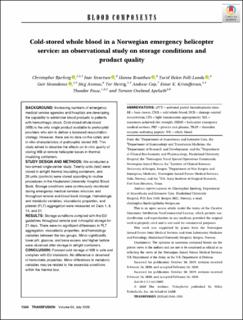| dc.contributor.author | Bjerkvig, Christopher Kalhagen | |
| dc.contributor.author | Sivertsen, Joar | |
| dc.contributor.author | Bråthen, Hanne Kristin | |
| dc.contributor.author | Lunde, Turid Helen Felli | |
| dc.contributor.author | Strandenes, Geir | |
| dc.contributor.author | Assmus, Jörg | |
| dc.contributor.author | Hervig, Tor | |
| dc.contributor.author | Cap, Andrew P. | |
| dc.contributor.author | Kristoffersen, Einar Klæboe | |
| dc.contributor.author | Fosse, Theodor | |
| dc.contributor.author | Apelseth, Torunn Oveland | |
| dc.date.accessioned | 2021-05-18T11:23:06Z | |
| dc.date.available | 2021-05-18T11:23:06Z | |
| dc.date.created | 2021-01-11T14:45:26Z | |
| dc.date.issued | 2020 | |
| dc.Published | Transfusion. 2020, 60 (7), 1544-1551. | |
| dc.identifier.issn | 0041-1132 | |
| dc.identifier.uri | https://hdl.handle.net/11250/2755450 | |
| dc.description.abstract | BACKGROUND
Increasing numbers of emergency medical service agencies and hospitals are developing the capability to administer blood products to patients with hemorrhagic shock. Cold‐stored whole blood (WB) is the only single product available to prehospital providers who aim to deliver a balanced resuscitation strategy. However, there are no data on the safety and in vitro characteristics of prehospital stored WB. This study aimed to describe the effects on in vitro quality of storing WB at remote helicopter bases in thermal insulating containers.
STUDY DESIGN AND METHODS
We conducted a two‐armed single‐center study. Twenty units (test) were stored in airtight thermal insulating containers, and 20 units (controls) were stored according to routine procedures in the Haukeland University Hospital Blood Bank. Storage conditions were continuously monitored during emergency medical services missions and throughout remote and blood bank storage. Hematologic and metabolic variables, viscoelastic properties, and platelet (PLT) aggregation were measured on Days 1, 8, 14, and 21.
RESULTS
Storage conditions complied with the EU guidelines throughout remote and in‐hospital storage for 21 days. There were no significant differences in PLT aggregation, viscoelastic properties, and hematology variables between the two groups. Minor significantly lower pH, glucose, and base excess and higher lactate were observed after storage in airtight containers.
CONCLUSION
Forward cold storage of WB is safe and complies with EU standards. No difference is observed in hemostatic properties. Minor differences in metabolic variables may be related to the anaerobic conditions within the thermal box. | en_US |
| dc.language.iso | eng | en_US |
| dc.publisher | Wiley | en_US |
| dc.rights | Navngivelse-Ikkekommersiell 4.0 Internasjonal | * |
| dc.rights.uri | http://creativecommons.org/licenses/by-nc/4.0/deed.no | * |
| dc.title | Cold-stored whole blood in a Norwegian emergency helicopter service: an observational study on storage conditions and product quality | en_US |
| dc.type | Journal article | en_US |
| dc.type | Peer reviewed | en_US |
| dc.description.version | publishedVersion | en_US |
| dc.rights.holder | Copyright 2020 The Authors | en_US |
| cristin.ispublished | true | |
| cristin.fulltext | original | |
| cristin.qualitycode | 1 | |
| dc.identifier.doi | 10.1111/trf.15802 | |
| dc.identifier.cristin | 1869133 | |
| dc.source.journal | Transfusion | en_US |
| dc.source.40 | 60 | |
| dc.source.14 | 7 | |
| dc.source.pagenumber | 1544-1551 | en_US |
| dc.identifier.citation | Transfusion. 2020, 60(7), 1544-1551 | en_US |
| dc.source.volume | 60 | en_US |
| dc.source.issue | 7 | en_US |

